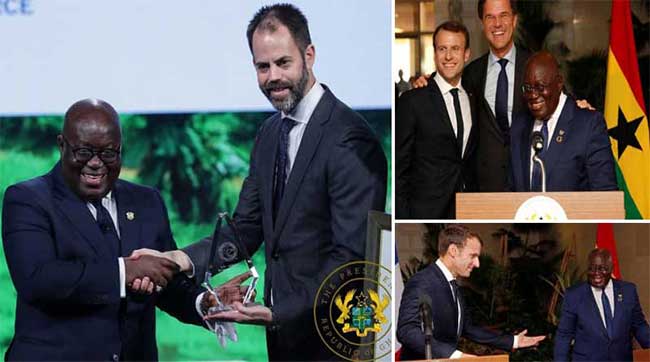Business & Finance

- Super User
- Category: Business & Finance
- Thursday, 02 March 2017 16:31
Stock Market Developments
41. Mr. Speaker, annual changes in the Ghana Stock Exchange Composite Index (GSE-CI) remained negative, generally reflecting investor preference for higher yielding money market instruments. The GSE Composite Index (GSE-CI) lost 15.3 percent (305.82 points) year-on-year in December 2016 to close at 1,689.09 points from 1,994.91 points in December 2015. Total market capitalization stood at GH¢52,690.99 million at the end of December 2016, showing a year-on-year decline of 7.8 percent.
Interest Rate
42. Mr. Speaker, interest rates in 2016 exhibited mixed performance. The Bank of Ghana Policy Rate was kept at 26 percent until October 2016 as risks to inflation and growth were assessed as balanced. The policy rate, however, was reduced to 25.5 percent, as inflation pressures eased while domestic growth conditions continued to deteriorate. Yields on short-term Government securities decreased, while those of medium to long-term GOG bonds increased in line with Government‟s policy to properly align the yield curve and extend the maturity profile.
Exchange Rate
43. Mr. Speaker, the Ghana cedi remained relatively stable against the major currencies in the currency market, on account of tighter monetary policy and improved foreign exchange inflows. However, this trend was reversed in the run-up to the December elections, as demand pressures mounted. The Ghana cedi recorded a cumulative depreciation of 9.6 percent and 5.3 percent against the US dollar and the euro, respectively, but appreciated by 10.0 percent against the pound sterling in the interbank market in 2016.
External Sector
44. Mr. Speaker, the balance of payments (BOP) turned surplus for the first time since 2011 due to improved current account balance. Accordingly, there was a build-up in gross foreign assets, which supported the relative stability in the exchange rate. The BOP surplus was US$247 million, compared to a deficit of US$129 million in 2015. The trade balance improved from a deficit of US$3.1bn in 2015 to a deficit of US$1.7bn in 2016 due to increased exports receipts by 7.2 percent and a decline in imports by 5.3 percent.
45. The gross foreign assets at the end of December was estimated at US$6,161.80 million, from US$5,884.70 million at the end of December 2015, representing a build-up of US$277.07 million. This was sufficient to provide cover for 3.5 months of imports of goods and services, same as in December 2015.
Fiscal Developments
46. Mr. Speaker, the main objective of fiscal policy, as envisioned in the 2016 Budget, was to consolidate
Government‟s finances by reducing the fiscal deficit from 6.3 percent of GDP in 2015 to 5.0 percent of GDP in 2016.
47. Provisional data for 2016, however, indicates that the envisioned fiscal consolidation was not achieved. As a result, total domestic revenue and grants was 11.1 percent below target (an actual of GH¢33.7 billion, against a target GH¢37.9 billion), while total Expenditure (including outstanding expenditure claims) exceeded the target by 16.2 percent. These slippages resulted in a fiscal deficit on commitment basis of 10.3 percent of GDP. On cash basis, the fiscal deficit was 8.7 percent of GDP against a target of 5.0 percent of GDP. The primary balance for the period, recorded a deficit of 1.4 percent of GDP, against a targeted surplus of 1.2 percent of GDP.
48. Mr. Speaker, the shortfall in total Revenue and Grants was broadly attributed to the impact of energy challenges on households and firms, lower than anticipated receipts from oil due to both lower-than-programmed benchmark crude oil price and production, and non-realisation of proceeds from both tax and non-tax categories. In addition, tax compliance was relatively weak.
49. Mr. Speaker, total expenditures (incl. outstanding obligations) amounted to GH¢51.1 billion at end-December 2016. Outstanding obligations of GH¢5 billion, comprise MDA obligations with MoF, which had not yet been captured on the GIFMIS as well as oustanding payments to Statutory Funds. The outstanding obligations relate mostly to Compensation of Employees, Goods and Services, and domestically financed
Capital Expenditure..
Petroleum Receipts in 2016
50. Mr Speaker, in 2016, GNPC lifted six parcels of crude oil (consisting of the 31st to 35th Jubilee and 1st TEN liftings) on behalf of the State, and exported a total of 21,580 MMscf of gas to Ghana National Gas Company (GNGC). Total crude lifted was 5,856,921 barrels of oil (4,860,462 barrels of Jubilee oil and 996,459 barrels of TEN oil). Receipts from crude oil liftings for 2016 included revenues from the sale of 4,824,417 barrels of oil from the 30th (lifted in December 2015) and the 34th Jubilee liftings, which amounted to US$207.79 million (GHȻ811.68 million). The proceeds from the 35th Jubilee and 1st TEN liftings in December 2016 were received in the first quarter of 2017. Mr. Speaker, actual petroleum receipts for 2016 fell short of the 2015 performance by 29.1 percent due to the continuous decline in crude oil prices, the decline in Jubilee production and lower TEN production.
Public Debt Development
51. Mr. Speaker, total public debt stock as at end 2016 stood at almost 73 percent of GDP up from 71.63 percent in 2015. This was due to the larger than expected fiscal deficit and financing requirement in 2016. Domestic and external debt stood at 31.7 percent of GDP and 40.8 percent, respectively. In nominal terms, the public debt stock as at end 2016 stood at GH₵122.3 billion (US$29.2 billion), with domestic and external debt of GH₵53.4 billion (US$12.8 billion) and GH₵68.9 billion (US$16.5 billion), respectively.
52. Energy Sector Levies
53. Mr. Speaker, the Energy Sector Levies Act, 2015 (Act 899) was enacted to “consolidate existing energy sector levies to ensure efficient utilisation of proceeds generated from the levies, impose a price stabilisation and recoveries levy to facilitate sustainable long term investments in the energy sector, and to provide for other related matters”.
54. Mr. Speaker, the law requires the utilisation of the energy sector levies mainly for the clearance of legacy debts of SOEs operating in the energy sector, to support power generation and power sector infrastructure, subsidy for premix fuel, and the stabilisation of petroleum prices.
55. A total amount of GH¢3.2 billion was programmed to be collected as total Energy Sector Levies (ESL) for the year 2016. Actual collections at the end of the year was GH¢3.3 billion. A breakdown of the utilization of the levies is provided in this Budget Statement.
56. Mr. Speaker, a few challenges have been encountered in the utilization of the proceeds and we will have to come to this august House for an amendment of the Act.
MACROECONOMIC TARGETS FOR 2017 AND THE MEDIUM TERM
57. Mr. Speaker, Government‟s policy objectives for the medium term among others will be to:
♦ build the most business-friendly and industrialized economy in Africa, capable of creating decent jobs and prosperity for all Ghanaians;
♦ modernize agriculture, improve production efficiency, achieve food security, and profitability for our farmers with special emphasis on value-addition;
♦ develop leadership skills, quality education, entrepreneurship, job skills and creative skills; and
♦ ensure a functioning social protection system which addresses the needs of the weak, marginalized, vulnerable and socially excluded; among others.
58. Mr. Speaker, to achieve our broad macroeconomic objectives, our policy direction will be to:
♦ restore and sustain macroeconomic stability;
♦ shift the focus of economic management from taxation to production;
♦ manage the economy competently; and
♦ make the machinery of government work to deliver the benefits of progress for all Ghanaians.
59. Mr. Speaker, prudent monetary and external sector policies will also be pursued by the Bank of Ghana to complement the fiscal policy stance to ensure price and exchange rate stability.
60. Mr. Speaker, we are confident that the above highlighted policies which are discussed in detail in the Budget Statement will contribute to the achievement of the following macroeconomic targets for 2017:
♦ overall real GDP growth of 6.3 percent;
♦ non-oil real GDP growth of 4.6 percent;
♦ end-year inflation of 11.2 percent;
♦ average inflation of 12.4 percent;
♦ overall fiscal deficit of 6.5 percent of GDP;
♦ primary surplus of 0.4 percent of GDP; and
♦ Gross Foreign Assets to cover at least 3 months of imports of goods and services.
61. Mr. Speaker, we believe strongly that our medium-term policies, anchored on fiscal discipline, a broadened tax base, elimination of wasteful expenditures, prudent debt management strategies, complementary monetary policy, and sustainable external balance will ensure even better macroeconomic outcomes in the medium-term. Consequently, the macroeconomic targets for the medium-term (2017-2019) include the following:
♦ overall real GDP growth to average 7.4 percent;
♦ non-oil real GDP growth to average 5.6 percent;
♦ inflation to be within the target band of 8±2 percent in the 2018-2019 period;
♦ overall fiscal deficit to reduce to 3 percent by the end of 2019;
♦ current account deficit projected to decline to 4.8 percent of GDP in 2018 and further to 2.7 percent of GDP in 2019; and
♦ Gross Foreign Assets to cover not less than 3.5 months of import of goods and services in the medium-term.
62. Mr. Speaker, consistent with Section 16 of the PFM Act, 2016 (Act 921), we have also set the following targets on primary and secondary fiscal indicators to monitor the fiscal health of the economy towards the achievement of our fiscal policy objectives in 2017:
♦ non-oil primary deficit of 0.8 percent of GDP;
♦ public debt stock equivalent to towards trend 70.9 percent of GDP;
♦ capital spending of 12.6 percent of total expenditures; and
♦ (domestic) revenue-to-GDP ratio of 21.4 percent
Resource Mobilization for 2017
63. Mr. Speaker, total Revenue and Grants, including programmed receipts from petroleum for the 2017 fiscal year, is estimated at GH¢44.9 billion (22.1 percent of GDP), indicating a 33.5 percent increase over the provisional outturn in 2016. Total non-petroleum Revenue and Grants is estimated at GH¢42.6 billion (21.4 percent of non-oil GDP) representing 29.2 percent increase over the provisional outturn in 2016.
64. Mr. Speaker, total receipts from petroleum is estimated at 1.2 percent of GDP and amounts to GH¢2.4 billion, representing a 231.2 percent increase over the outturn in 2016.
65. Domestic revenue is estimated at GH¢43.4 billion or 21.4 percent of GDP and is expected to be 33.5 percent higher than the provisional outturn in 2016.
66. Mr. Speaker, total tax revenue is estimated at GH¢34.4 billion, representing 6.9 percent of GDP. Of this amount, non-petroleum tax revenue is estimated to grow by 32.4 percent and this amounts to GH¢33.8 billion equivalent to 16.9 percent of non-oil GDP.
67. Taxes on Income and Property is estimated to increase by 47.7 percent to GH¢13.4 billion in 2017, accounting for 39.1 percent of total tax revenue. Of this amount, Royalties from petroleum is estimated at GH¢616.8 million.
68. Taxes on Goods and Services are estimated at GH¢13.9 billion, representing 13.3 percent increase over the provisional outturn in 2016 and 40.3 percent of the estimated total tax revenue for 2017.
69. International Trade taxes, are estimated at GH¢7.1 billion, representing 3.5 percent of GDP and 20.6 percent of total tax revenue. This estimate represents a 61.1 percent increase over the provisional outturn for 2016.
70. Mr. Speaker, the significant growth of this tax type emanates mainly from additional GH¢1.0 billion in tax measures that will be realised as savings from the reduction in the amount of import exemptions that will be granted in the 2017 fiscal year.
71. Mr. Speaker, Non-tax revenue, is estimated at GH¢6.7 billion (3.3 percent of GDP), representing 15.3 percent of domestic revenue. An amount of GH¢3.4 billion is expected to be
30
retained by MDAs for the funding of their activities and the rest lodged into the Consolidated Fund. Of the total amount estimated for Non-tax revenue, an amount of GH¢1.7 billion is estimated as non-tax petroleum revenue.
72. Mr. Speaker, grants from Development Partners is estimated at GH¢1.5 billion, equivalent to 0.8 percent of GDP.
Resource Allocation for 2017
73. Mr. Speaker, total expenditure, including provision made for the clearance of arrears and outstanding commitments in 2017 is estimated at GH¢58.1 billion, equivalent to 28.6 percent of GDP. The estimated expenditure for the year represents a 13.7 percent increase over the provisional outturn for 2016. Of this amount, GH¢3.7 billion, equivalent to 1.8 percent of GDP and 6.4 percent of total expenditure will be used for the clearance of arrears and outstanding commitments.
74. Mr. Speaker, provision has been made for the clearance of up to 20 percent of the outstanding claims from previous years whiles we await the outcome of a special forensic audit of these outstanding claims.
75. Mr. Speaker, Compensation of Employees is estimated at GH¢16.0 billion (7.9 percent of GDP). Of this amount, GH¢14.0 billion, equivalent to 6.9 percent of GDP.
76. Expenditure on Goods and Services is estimated at GH¢3.5 billion, representing 1.7 percent of GDP.
77. Total Interest Payment estimated at GH¢13.9 billion, represents 23.9 percent of total expenditure and is equivalent to 6.9 percent of GDP. Of this amount, domestic interest payment constitutes 80.5 percent of the total Interest Payment and amounts to GH¢11.2 billion.
78. Mr. Speaker, the existing legislation that have underpinned the estimation of Grants to other Government units over the years is being reviewed to break the cycle of rigidities in the Budget. Consequently, Grants to other Government units, comprising statutory payments into the National Health Insurance Fund, Ghana Education Trust Fund, the District Assemblies Common Fund, Road Fund, Energy Fund, transfer to the Ghana National Petroleum Company, retention of internally-generated funds by MDAs and other earmarked to a ceiling of 25 percent of tax revenues. The total allocation for grants to Other Government Units is GH¢9.7 billion.
79. Mr. Speaker, in addition to the significant tax incentives granted in this year‟s Budget, an amount of GH¢241.2 million has been budgeted in Social Benefits to assist lifeline consumers of electricity and transfers for social protection.
80. A total amount of GH¢7.1 billion has been allocated for capital expenditure. Of this amount, 38.9 percent will be financed from domestic sources and the remaining from foreign sources.
Overall Budget Balance and Financing for 2017
Click on the next arrow button to continue....



















































































